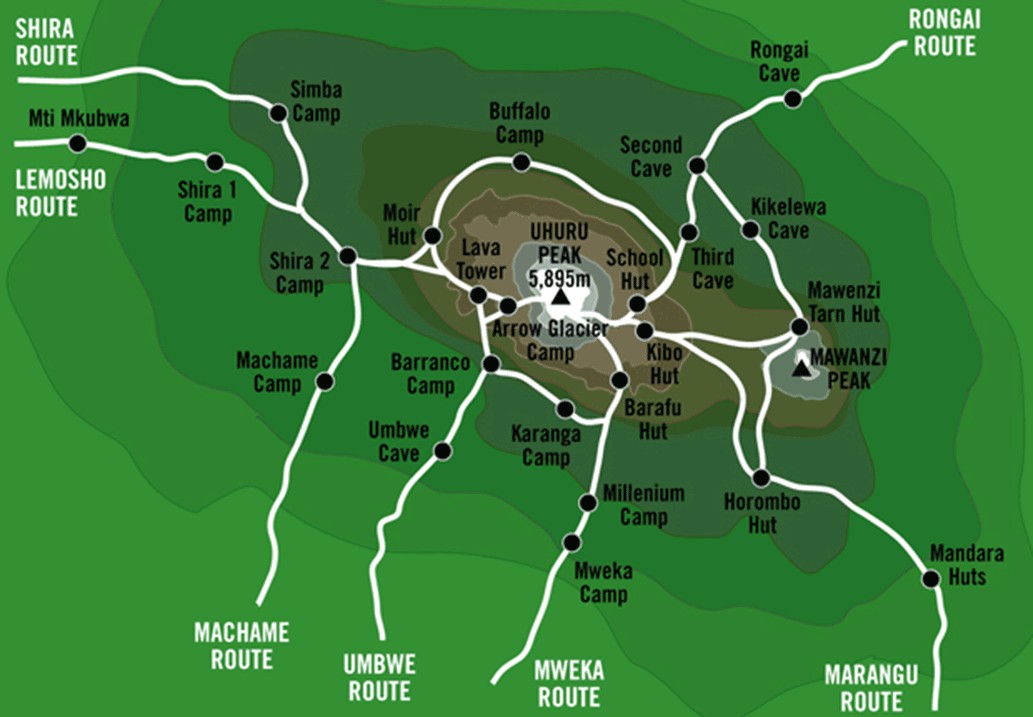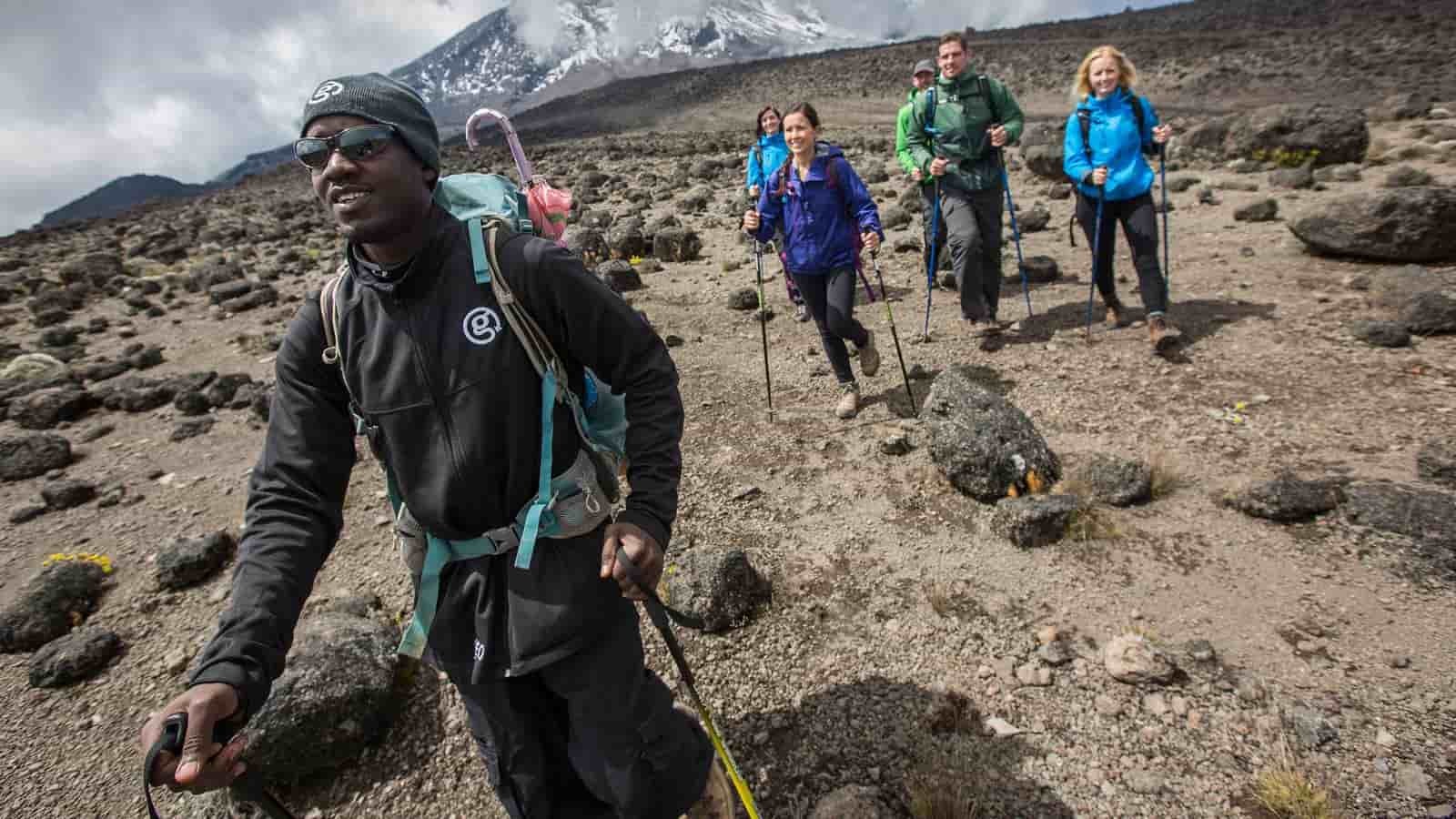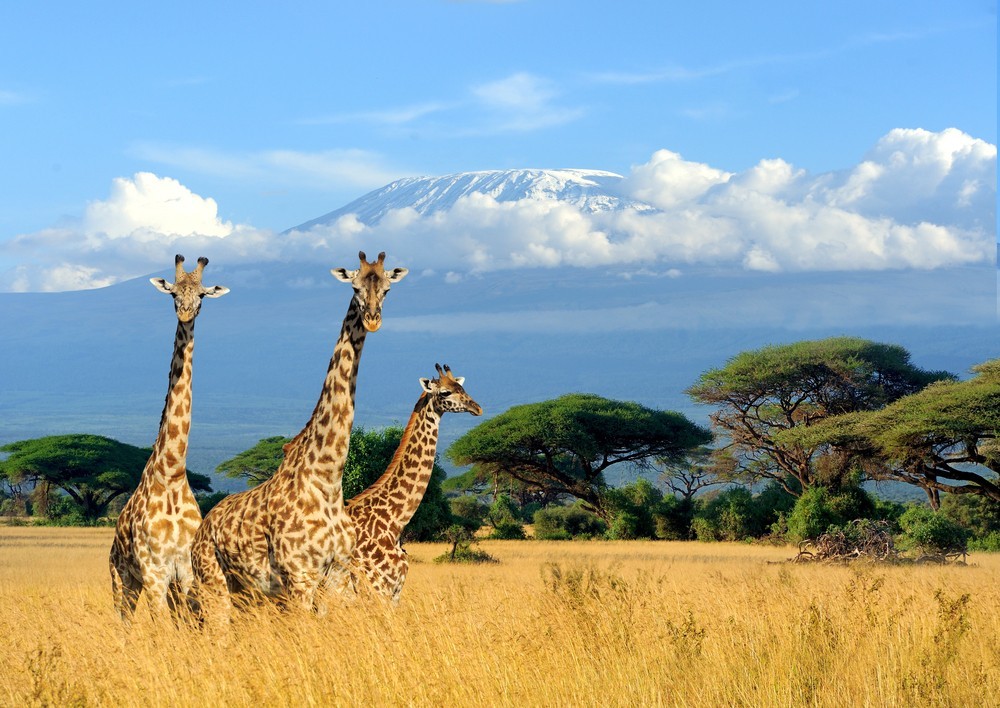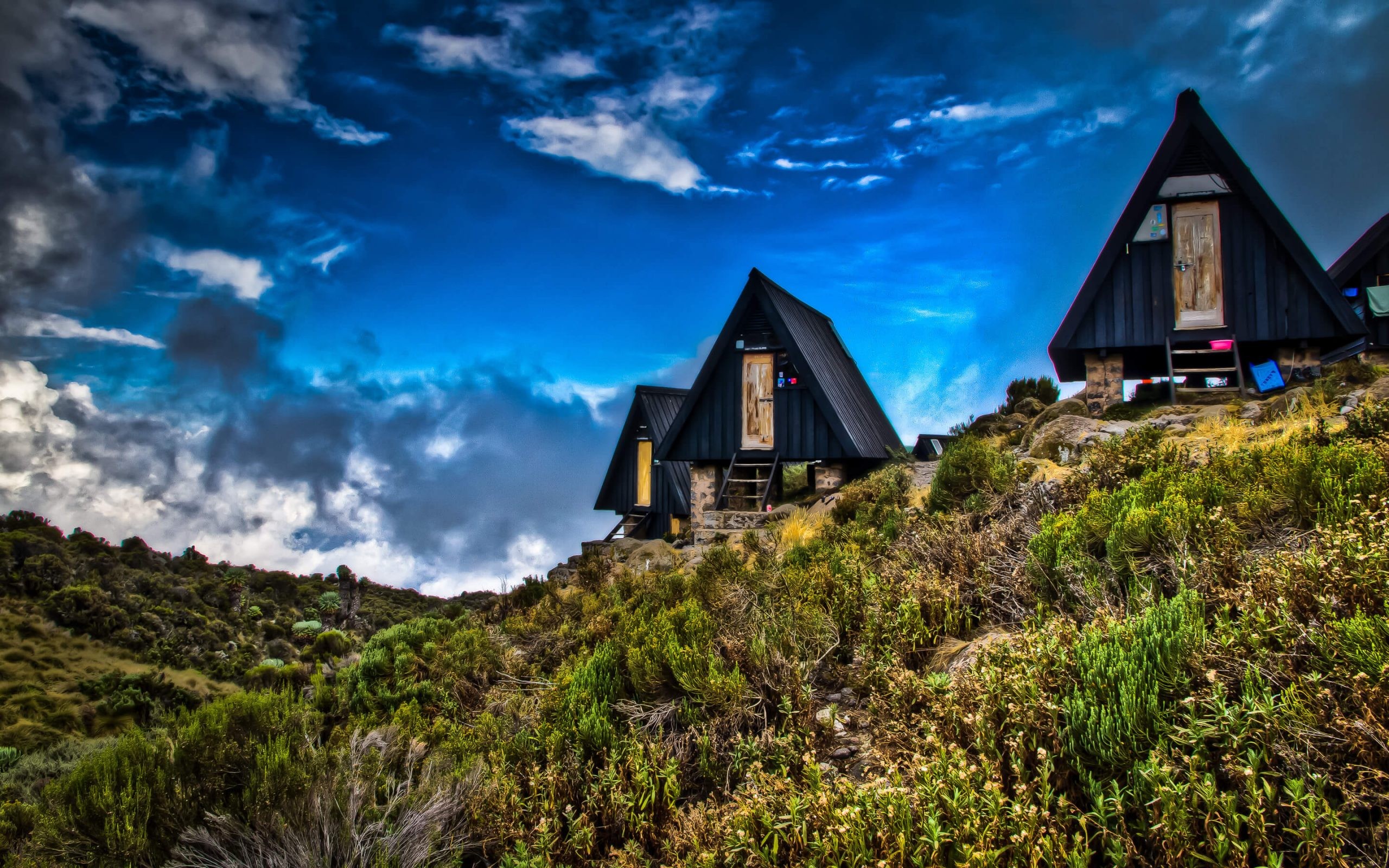Mount Kilimanjaro Tourism offers an unforgettable adventure, but planning it can be overwhelming. SIXT.VN provides expert travel advice and services to ensure a seamless experience, from airport transfers to booking accommodations. Discover the allure of Kilimanjaro tourism and let SIXT.VN guide you through this incredible journey with our comprehensive Kilimanjaro travel guide, Kilimanjaro tours and Mount Kilimanjaro climbing packages.
1. What Makes Mount Kilimanjaro a Popular Tourist Destination?
Mount Kilimanjaro is a renowned tourist destination due to its status as Africa’s highest peak and the world’s tallest free-standing mountain. The mountain’s diverse ecosystems, ranging from lush rainforests to alpine deserts, offer a unique trekking experience, attracting adventure seekers and nature enthusiasts alike. According to the Tanzania National Parks Authority (TANAPA), Mount Kilimanjaro National Park receives over 50,000 visitors annually, contributing significantly to Tanzania’s tourism sector. The iconic snow-capped summit and the challenge of reaching Uhuru Peak draw climbers from around the globe, making it a bucket-list destination for many.
1.1 What are the Key Attractions in Mount Kilimanjaro National Park?
The key attractions in Mount Kilimanjaro National Park include:
- Uhuru Peak: The highest point on Mount Kilimanjaro, offering breathtaking views.
- Shira Plateau: A scenic plateau ideal for acclimatization hikes and wildlife viewing.
- Lush Rainforests: Home to diverse flora and fauna at the mountain’s base.
- Wildlife Viewing: Opportunities to spot animals like elephants, buffaloes, and monkeys.
- Chala Crater Lake: A stunning crater lake near the Kenyan border, perfect for hiking and bird watching.
1.2 How Does Mount Kilimanjaro Contribute to Tanzania’s Tourism Industry?
Mount Kilimanjaro significantly boosts Tanzania’s tourism industry by attracting a large number of international tourists each year. According to a report by the World Travel & Tourism Council, tourism contributes approximately 11% to Tanzania’s GDP. The revenue generated from park fees, accommodation, tours, and related services supports local economies and funds conservation efforts. The mountain’s popularity also drives investment in infrastructure and hospitality services, further enhancing the tourism sector.
 Mount Kilimanjaro Tourism – The best view
Mount Kilimanjaro Tourism – The best view
2. What Are the Best Routes for Climbing Mount Kilimanjaro?
The best routes for climbing Mount Kilimanjaro vary in difficulty, scenery, and acclimatization profiles, including Machame, Marangu, Lemosho, and Rongai. According to Kilimanjaro National Park statistics, Machame and Lemosho are popular choices due to their scenic beauty and good acclimatization opportunities, increasing summit success rates. Marangu, known as the “Coca-Cola” route, is the only one with hut accommodations, while Rongai offers a remote and less crowded experience.
2.1 Machame Route
The Machame Route is a popular and scenic route, known for its challenging but rewarding climb.
- Duration: 6-7 days.
- Difficulty: Moderate to high.
- Scenery: Excellent, with diverse landscapes.
- Acclimatization: Good, with a “climb high, sleep low” profile.
2.2 Marangu Route
The Marangu Route is the only route with hut accommodations and is often called the “Coca-Cola” route.
- Duration: 5-6 days.
- Difficulty: Moderate.
- Scenery: Less varied compared to other routes.
- Acclimatization: Can be challenging due to the direct ascent.
2.3 Lemosho Route
The Lemosho Route is known for its beautiful scenery and high summit success rates.
- Duration: 7-8 days.
- Difficulty: Moderate.
- Scenery: Excellent, with remote and pristine landscapes.
- Acclimatization: Very good, with a gradual ascent.
2.4 Rongai Route
The Rongai Route approaches Kilimanjaro from the north, offering a quieter and less crowded experience.
- Duration: 6-7 days.
- Difficulty: Moderate.
- Scenery: Good, with unique northern views.
- Acclimatization: Decent, but less varied than other routes.
2.5 What Factors Should You Consider When Choosing a Climbing Route?
When choosing a climbing route, consider the following factors:
- Acclimatization: Routes with a gradual ascent and “climb high, sleep low” profile are better for acclimatization.
- Difficulty: Assess your fitness level and choose a route that matches your capabilities.
- Scenery: Consider the landscapes and views you want to experience during the climb.
- Crowds: If you prefer a quieter experience, opt for less popular routes like Rongai or Lemosho.
- Accommodation: Marangu is the only route with huts; all others require camping.
- Cost: Different routes may have varying costs due to length and required logistics.
 Mount Kilimanjaro Routes
Mount Kilimanjaro Routes
3. What Essential Hiking Gear is Needed for Climbing Kilimanjaro?
Essential hiking gear for climbing Mount Kilimanjaro includes appropriate clothing layers, sturdy hiking boots, and camping equipment. A detailed packing list from experienced tour operators like Zara Tours often includes thermal base layers, fleece jackets, waterproof outerwear, and a high-quality sleeping bag suitable for sub-zero temperatures. According to the Kilimanjaro National Park guidelines, proper gear is crucial for safety and comfort, reducing the risk of altitude sickness and hypothermia.
3.1 What Clothing is Recommended for Different Altitude Zones?
Recommended clothing for different altitude zones includes:
| Altitude Zone | Clothing |
|---|---|
| Base Camp (Low Altitude) | Lightweight, moisture-wicking shirts, hiking pants, sun hat |
| Montane Forest | Layered clothing, light fleece, rain jacket |
| Heather-Moorland | Mid-weight fleece, warm hat, gloves |
| Alpine Desert | Heavyweight fleece, insulated jacket, thermal pants, warm gloves and socks |
| Summit (Arctic Zone) | Extreme cold-weather gear, insulated parka, insulated pants, balaclava |
3.2 What are the Important Footwear and Trekking Accessories?
Important footwear and trekking accessories include:
- Hiking Boots: Sturdy, waterproof, and broken-in hiking boots with ankle support.
- Trekking Poles: Adjustable trekking poles to reduce strain on knees and provide stability.
- Gaiters: Waterproof gaiters to keep snow and debris out of boots.
- Socks: Moisture-wicking socks, with liner socks to prevent blisters.
- Headlamp: A reliable headlamp with extra batteries for navigating in the dark.
- Sunglasses: UV protection sunglasses to protect eyes from the intense sun at high altitudes.
- Water Bottles/Hydration Pack: Adequate water storage to stay hydrated.
3.3 Should You Rent or Buy Hiking Gear?
Whether to rent or buy hiking gear depends on the frequency of use and budget. For occasional climbers, renting gear from reputable outfitters near Mount Kilimanjaro, like those in Moshi or Arusha, can be a cost-effective option. However, for frequent hikers, investing in high-quality personal gear ensures comfort, proper fit, and reliability, which are crucial for a safe and enjoyable climbing experience.
 Hiking gear for Mount Kilimanjaro
Hiking gear for Mount Kilimanjaro
4. When is the Best Time to Visit Mount Kilimanjaro?
The best time to visit Mount Kilimanjaro is during the dry seasons, from June to October and December to March, according to the Tanzania Meteorological Agency. These months offer the most favorable weather conditions for climbing, with clear skies, minimal rainfall, and reduced chances of slippery trails. Visiting during these periods enhances safety and provides better visibility for enjoying the stunning landscapes.
4.1 How Does Weather Affect the Climbing Experience?
Weather significantly affects the climbing experience by influencing trail conditions, visibility, and the risk of altitude-related illnesses. Rainy seasons (November-December and March-May) can lead to muddy and slippery trails, increasing the difficulty and risk of accidents. Clear weather during the dry seasons allows for better views, easier navigation, and a more enjoyable overall experience. Temperature fluctuations, especially at higher altitudes, also require climbers to be prepared with appropriate clothing and gear.
4.2 What are the Peak and Off-Peak Seasons for Tourism?
Peak seasons for tourism on Mount Kilimanjaro are June to October and December to March, coinciding with the dry seasons. These periods see higher tourist numbers, increased prices for accommodations and tours, and potentially crowded trails. Off-peak seasons (November and March-May) offer fewer crowds and lower prices, but climbers must be prepared for wetter and potentially more challenging conditions.
4.3 How Should You Prepare for Different Weather Conditions?
To prepare for different weather conditions on Mount Kilimanjaro, climbers should:
- Pack Layers: Bring clothing that can be easily added or removed to adapt to changing temperatures.
- Waterproof Gear: Include waterproof jackets, pants, and backpack covers to stay dry during rain.
- Check Forecasts: Monitor weather forecasts regularly before and during the climb.
- Acclimatize Properly: Allow sufficient time for acclimatization to reduce the risk of altitude sickness, which can be exacerbated by cold and wet conditions.
- Flexible Itinerary: Be prepared to adjust the itinerary based on weather conditions to ensure safety.
5. What Wildlife Species Can Be Seen in Mount Kilimanjaro National Park?
Wildlife species in Mount Kilimanjaro National Park include a variety of mammals, birds, and primates adapted to the mountain’s diverse ecosystems. According to the Tanzania National Parks Authority, common sightings include elephants, buffaloes, colobus monkeys, and various bird species. While the primary focus is climbing, the opportunity to spot wildlife adds an extra layer of richness to the Kilimanjaro experience.
5.1 What Types of Animals Inhabit the Different Altitude Zones?
Different types of animals inhabit the different altitude zones, including:
| Altitude Zone | Animal Species |
|---|---|
| Montane Forest | Elephants, buffaloes, leopards, bushbucks, blue monkeys, colobus monkeys |
| Heather-Moorland | Elands, rodents, birds of prey |
| Alpine Desert | Limited wildlife due to harsh conditions; some birds and small mammals |
| Arctic Summit Zone | Virtually no wildlife |
5.2 Where Are the Best Locations for Wildlife Viewing?
The best locations for wildlife viewing are in the lower montane forest areas around the base of the mountain. Areas near the Namwai and Tarakia rivers are known for elephant sightings. The Shira Plateau also offers opportunities to see elands and other grazing animals. Guided nature walks are recommended to maximize wildlife viewing opportunities.
5.3 Are There Any Endangered Species in the Park?
Yes, there are several endangered species in the park, including the Abbot’s starling, which is a rare bird found in the montane forests. Conservation efforts are in place to protect these species and their habitats. Tourists can contribute to these efforts by supporting eco-friendly tour operators and following park guidelines.
 Mount Kilimanjaro National Park Wildlife
Mount Kilimanjaro National Park Wildlife
6. What Tourist Activities Are Available in Kilimanjaro National Park Besides Climbing?
Besides climbing, tourist activities available in Kilimanjaro National Park include bird watching, nature hikes, and cultural visits. According to the Tanzania Tourist Board, these activities provide diverse experiences for visitors who may not be interested in climbing but still want to explore the park’s natural and cultural heritage. These include exploring the lush landscapes, and immersing oneself in the local culture.
6.1 What are the Popular Nature Hikes and Walking Safaris?
Popular nature hikes and walking safaris include:
- Shira Plateau Hike: A scenic hike on the Shira Plateau, offering stunning views and wildlife spotting opportunities.
- Marangu Waterfall Hike: A guided hike to a beautiful waterfall near the Marangu gate.
- Coffee Plantation Tour: Visit local coffee plantations and learn about coffee cultivation.
- Chagga Cultural Tour: Experience the culture of the Chagga people, including visits to local farms and traditional homes.
6.2 How Can You Experience Local Culture Near Kilimanjaro?
You can experience local culture near Kilimanjaro by:
- Visiting Local Villages: Interact with the Chagga people and learn about their traditions and way of life.
- Attending Cultural Events: Participate in local festivals and ceremonies.
- Supporting Local Businesses: Purchase handicrafts and souvenirs from local artisans.
- Staying in Community-Based Lodges: Support local communities by staying in eco-friendly lodges that benefit the local economy.
6.3 What Unique Attractions Can Be Found in the Park?
Unique attractions in the park include:
- Chala Crater Lake: A beautiful crater lake offering swimming and hiking opportunities.
- Olpopongi Maasai Cultural Village: Experience authentic Maasai culture and traditions.
- Kilimanjaro’s Glaciers: Witness the iconic glaciers (though diminishing) on the summit.
- Diverse Ecosystems: Explore the park’s five distinct climatic zones, each with unique flora and fauna.
 Hiking Kilimanjaro
Hiking Kilimanjaro
7. What Types of Accommodation Are Available in and Around Kilimanjaro National Park?
Accommodation options in and around Kilimanjaro National Park range from basic campsites to luxury lodges, catering to various budgets and preferences. Within the park, camping is the primary option for climbers on most routes, while just outside the park, towns like Moshi and Arusha offer a wide array of hotels and guesthouses. According to booking data, lodges and hotels in these areas provide a comfortable base for pre- and post-climb relaxation.
7.1 What Are the Camping Facilities Like on the Mountain?
Camping facilities on the mountain are generally basic, providing designated camping spots with limited amenities. Tour operators typically supply tents, sleeping bags, and cooking equipment. Some campsites have basic toilet facilities, but cleanliness can vary. Climbers should be prepared for primitive conditions and practice Leave No Trace principles.
7.2 What Hotels and Lodges Are Recommended in Moshi and Arusha?
Recommended hotels and lodges in Moshi and Arusha include:
| Accommodation | Description |
|---|---|
| Kilimanjaro Wonders Hotel | A comfortable hotel in Moshi with good reviews for its service and amenities. |
| Sal Salinero Hotel Arusha | A luxury lodge in Arusha offering excellent amenities and a relaxing atmosphere. |
| Rivertrees Country Inn | A charming inn near Arusha with beautiful gardens and a tranquil setting. |
| Mount Meru Hotel | A well-known hotel in Arusha, offering a range of facilities and services. |
| Aishi Machame Hotel | A budget-friendly option in Moshi with clean rooms and a convenient location. |
| Bristol Cottages Arusha | Offers self-catering cottages with a focus on privacy and comfort, located in a serene part of Arusha. |
| The Bay Leaf Boutique Hotel | A boutique hotel known for its elegant design, personalized service, and tranquil ambiance in Arusha’s suburbs. |
7.3 Are There Any Eco-Friendly Accommodation Options?
Yes, there are several eco-friendly accommodation options around Kilimanjaro, focusing on sustainable practices and supporting local communities. These include:
- Weru Weru River Lodge: An eco-lodge near Moshi with a focus on sustainable tourism.
- Kia Lodge: A lodge built with eco-friendly materials and practices.
- Onsea House: A boutique hotel near Arusha committed to environmental conservation.
 Mount Kilimanjaro Huts
Mount Kilimanjaro Huts
8. When Is The Best Time Of The Year To Climb Mount Kilimanjaro?
The best months to climb Mount Kilimanjaro are typically during the dry season which runs from June to October. These months offer more stable weather conditions with lower rainfall and clearer skies, making the ascent safer and more enjoyable. The months from December to March also present a favorable window, avoiding the heavier rains that occur in April and May.
8.1 Weather Patterns And Seasonal Variations
Weather on Kilimanjaro varies significantly with altitude and time of year. The mountain experiences distinct wet and dry seasons. The long dry season spans from June to October, characterized by sunny skies and minimal rainfall, ideal for trekking. The short rainy season occurs in November and December, followed by another drier period from late December to March. The long rainy season lasts from April to May, bringing heavy rains and making trails slippery and more challenging.
8.2 How To Take Advantage Of The Dry Season
To make the most of the dry season for a Kilimanjaro climb, consider these strategies:
- Book in Advance: Secure accommodations, permits, and guides well ahead of time due to higher demand.
- Pack Appropriately: Even during the dry season, temperatures can fluctuate drastically, so bring layers and waterproof gear.
- Acclimatize Gradually: Plan an itinerary that allows for gradual acclimatization to reduce the risk of altitude sickness.
8.3 Seasonal Challenges And Mitigation Strategies
Climbing Kilimanjaro during the rainy season presents unique challenges:
- Slippery Trails: Use sturdy trekking poles and wear boots with good traction.
- Heavy Rain: Pack high-quality rain gear, including a waterproof jacket, pants, and backpack cover.
- Reduced Visibility: Be prepared for limited views and potential delays due to poor weather conditions.
9. Where Exactly Is Kilimanjaro Located?
Mount Kilimanjaro is located in Tanzania, East Africa, near the Kenyan border. Its geographic coordinates are approximately 3.0662° S latitude and 37.3591° E longitude. Situated in the Kilimanjaro National Park, it is easily accessible from nearby towns such as Moshi and Arusha.
9.1 Accessibility Options By Air
Kilimanjaro International Airport (JRO) is the primary airport serving Mount Kilimanjaro, making it easily accessible by air. The airport accommodates direct flights from major international hubs. Airlines such as KLM, Qatar Airways, Ethiopian Airlines, and Turkish Airlines offer direct routes to JRO. Additionally, connecting flights via Nairobi (Kenya) or Addis Ababa (Ethiopia) are available through Kenya Airways and Ethiopian Airlines, respectively.
9.2 Road Transportation Logistics
Road transportation to Kilimanjaro is well-organized, with various options available from nearby towns:
- From Moshi: A short drive of approximately 45 minutes to an hour will take you to the Kilimanjaro National Park gate. Taxis and shuttle services are readily available.
- From Arusha: The journey takes about 2 to 3 hours. Many tour operators include transportation in their packages, or private transfers can be arranged.
9.3 Proximity To Key Cities And Parks
Kilimanjaro’s strategic location offers opportunities to explore other attractions in the region:
- Arusha: Serves as a popular starting point for safaris to Serengeti, Ngorongoro Crater, and Tarangire National Park.
- Moshi: Known for its coffee plantations and cultural tours, providing insights into local life.
10. How Was Mount Kilimanjaro Formed?
Mount Kilimanjaro’s formation is a result of volcanic activity stemming from the Great Rift Valley. Approximately one million years ago, volcanic eruptions began to build the mountain, creating three distinct volcanic cones: Kibo, Mawenzi, and Shira.
10.1 Geographical Transformation Of The Mountain Over Millions Of Years
Over millions of years, Mount Kilimanjaro underwent significant geographical transformations:
- Initial Volcanic Activity: The initial eruptions formed Shira, the oldest of the three cones.
- Cone Development: Subsequent eruptions led to the creation of Mawenzi and Kibo.
- Erosion and Collapse: Shira eventually collapsed, forming the Shira Plateau. Mawenzi and Kibo remained, with Kibo, the youngest, becoming the highest point.
10.2 Tectonic Forces At Play In East Africa
The tectonic forces in East Africa played a crucial role in the formation of Mount Kilimanjaro. The Great Rift Valley, a zone of significant tectonic activity, weakened the Earth’s crust, allowing magma to rise and erupt.
10.3 Impact Of Volcanic Activity On The Local Ecosystem
Volcanic activity has had a profound impact on the local ecosystem:
- Soil Enrichment: Volcanic ash has enriched the soil, creating fertile grounds for diverse vegetation.
- Water Sources: The mountain’s volcanic structure helps capture and store water, providing essential resources for the surrounding areas.
- Biodiversity: The unique combination of altitude, climate, and volcanic soil supports a rich variety of plant and animal life, contributing to the region’s biodiversity.
Address: 260 Cau Giay, Hanoi, Vietnam. Hotline/Whatsapp: +84 986 244 358. Website: SIXT.VN.
FAQ About Mount Kilimanjaro Tourism
1. Is climbing Mount Kilimanjaro difficult?
Climbing Mount Kilimanjaro can be challenging due to the high altitude, but it is achievable for people with good fitness levels and proper acclimatization.
2. How much does it cost to climb Mount Kilimanjaro?
The cost varies depending on the route, duration, and level of service, but typically ranges from $2,000 to $6,000 per person.
3. What are the risks associated with climbing Kilimanjaro?
Risks include altitude sickness, hypothermia, and injuries from falls. Proper preparation and guidance can mitigate these risks.
4. What is altitude sickness and how can it be prevented?
Altitude sickness is caused by reduced oxygen levels at high altitudes. It can be prevented by acclimatizing gradually and staying hydrated.
5. What vaccinations and health precautions are necessary for visiting Kilimanjaro?
Consult with your doctor for recommended vaccinations, such as yellow fever, and take precautions against malaria and other mosquito-borne diseases.
6. Can you climb Mount Kilimanjaro without prior mountaineering experience?
Yes, you can climb Mount Kilimanjaro without prior mountaineering experience, but good physical fitness and proper preparation are essential.
7. What is the success rate for summiting Mount Kilimanjaro?
The success rate varies by route, but it is generally between 40% and 60%.
8. What is the role of porters and guides on Kilimanjaro climbs?
Porters carry your gear, and guides provide expertise, support, and ensure your safety during the climb.
9. What cultural etiquette should I be aware of when visiting Tanzania?
Respect local customs, dress modestly, and ask for permission before taking photographs of people.
10. How can I book a Mount Kilimanjaro climb?
You can book a climb through reputable tour operators who specialize in Kilimanjaro expeditions.
Ready to embark on your Kilimanjaro adventure? Contact SIXT.VN today to book your personalized tour and experience the magic of Africa’s highest peak. Visit SIXT.VN or call +84 986 244 358 for more information.



